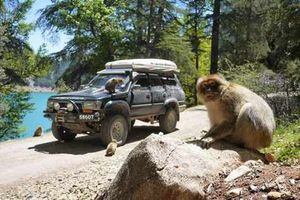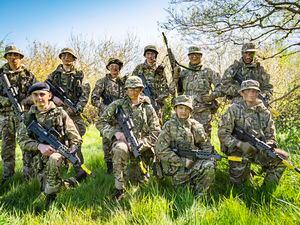Natural highs
Andy Smith and Emma Smart – and their 18-year-old Toyota Hilux, Bee-bee – are driving around the world, stopping occasionally to help out chosen charities. So far, we have followed their adventures in Scandinavia, Russia and Mongolia. The pair have now ventured into Africa, where Andy takes up the story...

Andy Smith and Emma Smart – and their 18-year-old Toyota Hilux, Bee-bee – are driving around the world, stopping occasionally to help out chosen charities. So far, we have followed their adventures in Scandinavia, Russia and Mongolia. The pair have now ventured into Africa, where Andy takes up the story...
AFTER an unplanned return drive to Guernsey from Mongolia late last year due to illness in the family, we had to re-evaluate our 'around the world' route.
Given the situation it was going to be impossible to pick up our original route in Kazakhstan so we formulated a new plan. We decided not to venture too far, so a no-commitments plan down to Morocco was made with the idea that if we needed to return home quickly we could.
With Scandinavia, Russia and Mongolia under our belt, a trip to North Africa wasn't so daunting. On a wet, drizzly morning in February we loaded up the last of our equipment into 'Bee-bee', our 18 year-old Toyota Hilux Surf, and set sail for France.
We drove quickly through France and Spain with our sights set on the warmer climate of Morocco. An interlude to 'Rock the Casbah' with family in Marrakech was planned followed by a meander to the Western Sahara, by which time we should have warmed up considerably.
Limited by a closed border to Algeria in the east and an increasingly dodgy pass to Mauritania in the south, we would be land-locked by civil unrest and political restrictions. However, with around 450,000km2 we had plenty to explore with the Sahara desert, Atlas Mountains and wild Atlantic coastline.
The transition from the familiarity of Europe to the unfamiliar of Africa is only a 90-minute sail across the Straits of Gibraltar. As with the arrival to any foreign country for the first time, there is always the excitement, yet slight trepidation of the unknown; language, money, people, food, culture, roads and everyday life.
Our initial route in Morocco took us down the Atlantic coast; after a very chilly drive through France and Spain, the days were now warmer but by sunset the temperature fell sharply.
Our first stop on this wild coastline, Asilah, was our introduction to a Moroccan town; the medina (the walled part of an Arabic town) was a labyrinth of narrow lanes and alleys dotted with doorways encircled by intricate colourful tiled mosaics. Revving scooters veering perilously through the alleyways break the silence.
Outside this enclosed habitation, you step onto the main street and are met with an immediate sensory onslaught. Donkey carts, cars, bikes, horses and people jostle rowdily for position on the road.
From the coast we headed inland to Marrakech to meet family.
The heart of Marrakech is Djemaa el Fna square.
During the day it's a comparatively sedate scene, although still impossible to cross without being intercepted by trinket hawkers, water sellers, snake charmers and orange-juice vendors. Horse-drawn carriages lug tourists around its periphery while those on foot vigilantly dodge having snakes draped around their necks or monkeys placed on their shoulders.
By late afternoon the food stalls begin to set up; rows of temporary eateries consisting of a central preparation and grilling area surrounded by a few tables and benches.
Smoke wafts from these makeshift restaurants that serve up tagines, spicy sausages and grilled kebabs, cous cous, steamed snails, whole sheep's head and brains, sweet chicken pastilla, salads and bowls of steaming harira soup.
As the sun sets, storytellers and acrobats attract crowds encircling their animated performances. Impromptu music sessions start up, with amateur musicians perched on wooden stools around lamps illuminating their faces nodding to the hypnotic drum beat.
A week later, we left Marrakech and began our real adventure.
Our first real taste of off-road driving came as we decided to go over the High Atlas Mountains for a third time. After crossing twice on two stunning paved roads, we decided to opt for a more challenging route on our third pass.
Heading north from the small town of Timesgadiouine, we had planned on doing a one-day north-easterly circuit passing over the 3,205-metre Djebal Tabgourt. With our 1:1,000,000 Reise Know-How map in hand, we set off. After about an hour's drive it became blatantly apparent that all our map was good for was toilet paper if we got caught short. Relying on our GPS compass for direction, we carried on regardless to try to navigate the barely wider than Bee-bee tracks.
The route we took was scarcely driven, rocky and featured a few hair-raising cliff drops. After a full day's drive it dawned on us that we were not going to get off the mountain before sunset. We drove until the light dropped and soon our situation became the start of one of those 'When Things Go Bad' TV programmes as we found ourselves setting up camp on a precipitous edge in -2°C at the top of the wind-blown mountain.
The next day's driving was equally as challenging and featured several slightly daunting drop-offs.
The descent was steep and involved rock crawling that was so heavy on the brakes they literally stopped working, requiring us to pause in a little village to let them cool down.
After nearly two full days of driving, we arrived in a small settlement where we had to pass between two buildings; thankfully the gap was about 20cm wider than Bee-bee. Travelling these tracks in anything bigger than a Hilux would have caused problems; on our entire route we rarely encountered places wide enough to pass oncoming vehicles, let alone turn around. Luckily we didn't have to do either, emphasising just how little traffic passes along these routes.
From the High Atlas we headed south, taking in the dramatic Atlantic coastline again. Located on the coast just south of Sidi Ifni is Fort Bou Jerif, a clichéd French Legion fort, the kind you'd see in a Sunday afternoon movie. It is also right next to the site of a rather trendy boutique campsite of the same name.
After a couple of nights wild camping, we owed it to each other to have a hot shower and so heading off-road we attempted to follow the rather useless signs (foolishly failing to make a note of the GPS coordinates that were written on the first sign).
After approximately 11 miles off piste and a few wrong turns, we finally got our first view of the rather impressive fort. Getting closer, we realised that the previous three days' heavy rain had resulted in a flooded wadi flowing rapidly between a hot shower and us.





